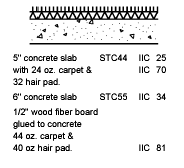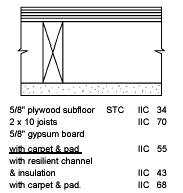Print Page
Facts About Noise Control
- The major factor controlling the sound insulation of a given type of cavity floor is the sum of the masses per unit area of the floor and the ceiling layers.
- Of lesser importance, but still significant, are the thickness and density of the sound-absorbing material. The depth and spacing of the joists and the spacing of resilient metal channels for ceiling finishes. Increasing any of these variables increases the sound insulation.
- Floor/ceiling assemblies having no sound-absorbing materials provide about 8 STC points less than the same assemblies containing about a 6″ thickness of sound-absorbing material.
- Joist type floor/ceiling assemblies without resilient channels do not achieve an STC 50 in any practical configuration with or without sound-absorbing material in the cavity.
- Wood furring or metal hat channels to support the gypsum board ceiling are markedly inferior to resilient metal channels.
- Attaching the sub-floor material to the joists with both construction adhesive and nails gave approximately the same results as with only screws for attachment.
- Joist floors with ceiling assemblies having resilient channels between 2 layers of gypsum board give very poor sound insulation. (Adding a resilient channel to an existing gypsum surface and adding another layer of gypsum board will do little or nothing to improve the sound insulation of the wall or ceiling assembly.)
- Applying sound absorbing material in the cavity of a joist floor with a ceiling that is not resiliently suspended will provide no significant increase in sound insulation.
- Floors with concrete toppings and no additional resilient surface or support typically will get impact isolation class (IIC) ratings of less than 30. Adding resilient surface layers to floors with concrete surfaces greatly increases the IIC ratings.
Example Floor Ratings





